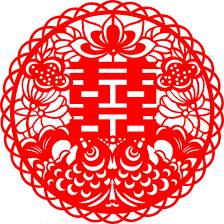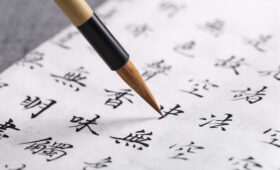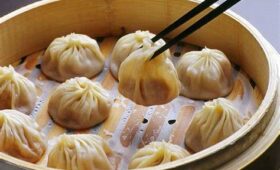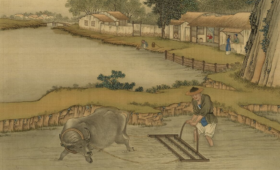The art of Chinese papercutting in China may date back to the 2nd century CE,
when paper was invented by Cai Lun,a court official of the Eastern Han Dynasty.
Chinese paper cutting is a treasured traditional Chinese art dating back to when paper was developed.
Paper cutting became popular as a way of decorating doors and windows as paper became more accessible.
These elaborate cutting designs are created with scissors or artwork knives and can include a variety of shapes,
such as symbols and animals.
As paper became more affordable,
paper-cutting became one of the most important types of Chinese folk art.
Later, this art form spread to other parts of the world,
with different regions adopting their own cultural styles.
Because the cut-outs are often used to decorate doors and windows,
they are sometimes referred to as “window flowers” or “window paper-cuts”.
These cut-paper decorations are often glued to the exterior of windows,
so the light from the inside shines through the negative space of the cutout.
Usually,the artworks are made of red paper,
as red is associated with festivities and luck in Chinese culture,
but other colours are also used. Normally cut-paper artwork is used on festivals
such as Chinese New Year, weddings and childbirth,
as cut-paper artwork is considered to symbolize luck and happiness.
Origin
Chinese paper-cutting originated from the practice of worship of both ancestors and gods,
a traditional part of Chinese culture dating back roughly two millennia.
According to archaeological records,it originates from the 6th century,
although some believe that its history could be traced back as far as the Warring States period (around 3 BC),
long before paper was invented.
At that time, people used other thin materials, like leaves, silver foil, silk and even leather,
to carve negative-space patterns.
Later, when paper was invented, people realized that this material was easy to cut, store and discard,
and paper became the major material for this type of artwork.
Tang Dynasty & Song Dynasty
During the Tang Dynasty, Chinese Papercutting developed rapidly and became popular in China,
which typically combined paper cutting with painting to illustrate spiritual ideas.
Chinese Papercutting as an artform matured during the Tang dynasty,
where it became considered not only a type of handicraft, but also a type of artwork,
as ideas and concepts were expressed through the pattern cut into the paper.
During the Song Dynasty,
Chinese papercutting developed into a more advanced technique,
with trained artisans creating more complex artworks.
The technique was used to decorate ceramics and make shadow puppets.
By carving patterns onto oily cardboard and scraping patterns onto the fabric,
blue-printed fabric came about.
Ming and Qing Dynasties
In the Ming and Qing dynasty, Chinese Papercutting is reached a developmental peak.
Folk Chinese Papercutting spread to a wider range of people,
and expressed an abundance of artistic expression.
Paper-cutting was used to decorate doors, windows and walls,
to show happiness and celebrate festivals.
During the Ming and Qing dynasties, papercutting became a more popular Chinese art form.
There are a variety of uses, including lantern and fan ornaments, needlework patterns, and window flowers.
The imperial family also utilized papercutting,
with the Forbidden City decorated with papercuts during the emperor’s wedding ceremony.
Its continual appeal reflects the Chinese people’s creativity,
with designs expressing cultural ideas and values.
Characteristics
Chinese papercutting is an art form from the Chinese cultural legacy
that displays a wide range of designs,
from simple basic designs consisting of a single image to symmetrical,
which are created by folding the paper into proportionate portions before cutting,
so that when unfolded,it forms a symmetrical design,
and are usually folded into an even number,such as twice or four times.
Typically, the designs are freeform and depict scenes from daily life.
Red paper is the most prevalent because it is connected with happiness and good fortune in Chinese culture.
Thus,it is popularly used to celebrate important events such as weddings and festivals.
Paper cutting is consistently evolving and has developed beyond China,
with artists developing new techniques and materials to keep this art form alive.
During the Ming and Qing dynasties (1368–1912),
this artistry witnessed its most prosperous period.
For over a thousand years, people (mainly women) created cut-paper artworks as a leisure activity,
creating different types of paper-cutting and passing this traditional craft onto their children,
resulting in the artform becoming more popular.
Paper-cutting is still practiced as an artform in modern-day China as a result.
Symbolic Use
The most popular papercutting Chinese characters are the characters lucky and double happiness.
The character lucky is often displayed during Chinese New Year celebrations to bring fortune and prosperity for the coming year.
The character double happiness is commonly used for weddings,
and the hope for a fulfilling marriage.
These papercuts are important Chinese cultural symbols and are cherished for their aesthetic beauty.
Chinese papercutting has educational uses that teach children
about traditional Chinese art and culture and the beauty of papercutting
while learning Chinese papercutting history.
Practicing paper cuts also helps children enhance their fine motor skills,
hand-eye coordination, and creativity.
Chinese paper cuttings’ designs are often used to express hopes,
appreciation, and other spiritual emotions.
Common Chinese papercutting motifs include representations of harvests,
animals, and mythical stories such as the carp jumping over the dragon gate.
Chinese people express cultural heritage,
values, and beliefs through the art of papercutting,
making it a significant element of their spiritual expression.




